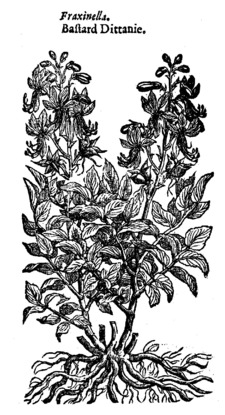
Gerard's Herbal

Fig. 1770. Bastard Dittany
The Description.
Bastard Dittany is a very rare and gallant plant, having many brown stalks, somewhat rough, divided into sundry small branches, garnished with leaves like Liquorice, or rather like the leaves of the Ash tree, but blacker, thicker, and more full of juice, of an unpleasant savour: among which grow flowers, consisting of five whitish leaves striped with red, whereof one which groweth undermost hangeth down low; but the four which grow uppermost grow more stiff and upright: out of the midst of this flower cometh forth a tassel, which is like a beard, hanging also downwards, and somewhat turning up at the lower end: which being faded, there come in place four husks joined together, much like the husks or cods of Columbines, somewhat rough without, slimy to handle, and of a loathsome savour, almost like the smell of a goat; whereupon some herbarists have called it Tragium; in the cods are contained small black shining seeds like Peony seeds in colour: the roots are white, a finger thick, one twisting or knotting within another, in taste somewhat bitter.
There is another kind hereof growing in my garden, not very much differing: the leaves of the one are greater, greener, harder, and sharper pointed: of the other blacker, not so hard, nor so sharp pointed: the flowers also hereof be something more bright coloured, and of the other a little redder.
The Place.
Bastard Dittany groweth wild in the mountains of Italy and Germany, and I have it growing in my garden.
The Time.
It flowereth in June and July: the seed is ripe in the end of August.
The Names.
The later herbarists name it Fraxinella: most, Chamomilion, as though they should say Humilis fraxinus or a low Ash: in English, Bastard, or False Dittany: the shops call it Dictamnum, and Diptamum, but not truly, and use oftentimes the roots hereof instead of the right Dittany. That it is not the right Dittany it is better known than needful at all to be confuted; and it is as evident that the same is not Dioscorides his Pseudodictamnum, or Bastard Dittany: but it is plain to be a kind of Tragium of the old Writers, wherewith it seemeth to agree in show, but not in substance.
The root of this is only used in shops, and there known by the name of Radix Diptamni, or Dictamni.
The Temperature.
The root of Bastard Dittany is hot and dry in the second degreee, it is of a wasting, attenuating, and opening faculty.
The Virtues.
A. It bringeth down the menses, it also bringeth away the birth and afterbirth; it helpeth cold diseases of the matrix: and it is reported to be good for those that have ill stomachs and are short-winded.
B. They also say, that it is profitable against the stingings and bitings of venomous serpents; against deadly poisons, against contagious and pestilent diseases, and that it is with good success mixed with counterpoisons.
C. The seed of Bastard Dittany taken in the quantity of a dram is good against the strangury, provoketh urine, breaketh the stone in the bladder, and driveth it forth.
D. The like virtue hath the leaves and juice taken after the same sort, and being applied outwardly, it draweth thorns and splinters out of the flesh.
E. The root taken with a little Rhubarb killeth and driveth forth worms.
F. Dioscorides reporteth, that the wild goats being stricken with darts or arrows, will eat Dictam, and thereby cause them to fall out of their bodies; which is meant of the right Dictam, though Dodonĉus reporteth that this plant will do the like (saith our author, which I do not believe, nor doth Dodonĉus affirm it.)